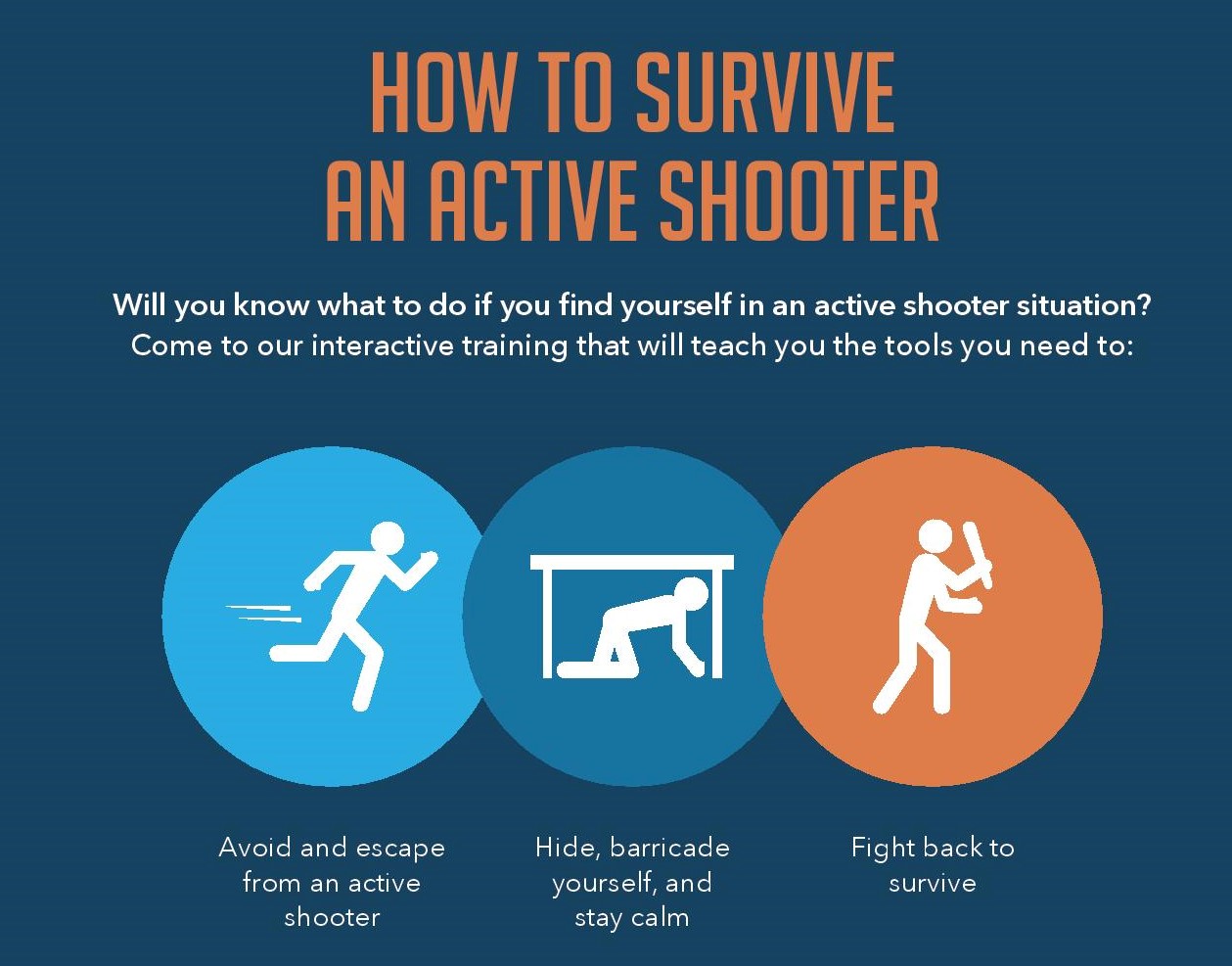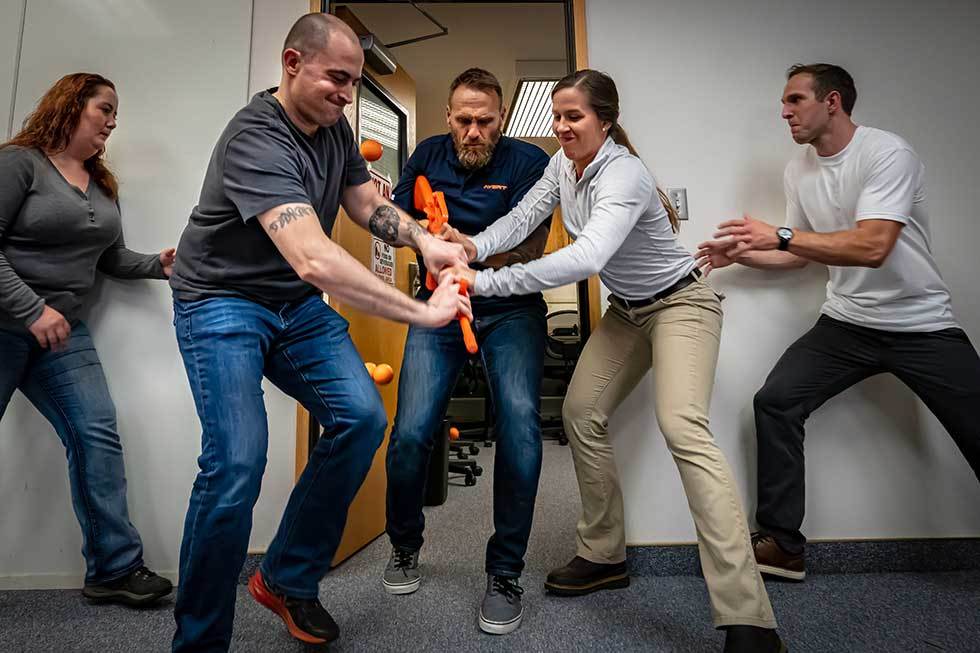Why Active Shooter Training Is Vital for Office Safety And Security
Why Active Shooter Training Is Vital for Office Safety And Security
Blog Article
The Essential Function of Active Shooter Training in Enhancing Emergency Reaction Approaches in Different Atmospheres
Energetic shooter training has become a fundamental part in refining emergency action approaches across varied settings, from universities to corporate atmospheres. By gearing up individuals with tailored understanding and abilities, these programs not only prepare participants for possible dilemmas yet likewise foster a culture of recognition and collaboration. The performance of such training hinges on various aspects, including the certain context in which it is carried out and the ongoing commitment to enhancement. Exploring these dimensions discloses important insights that can significantly influence preparedness and response outcomes in the face of startling hazards.
Value of Energetic Shooter Training
In a period noted by enhancing problems over public safety, the relevance of energetic shooter training can not be overstated. As incidents of gun physical violence in public spaces remain to rise, companies throughout various sectorsâEUR" academic establishments, offices, and public venuesâEUR" are recognizing the necessity of preparing their workers and communities for such emergencies. Energetic shooter training gears up people with important abilities and knowledge to respond properly in dangerous circumstances, potentially lessening casualties and conserving lives.
The training not just focuses on instant reaction activities, such as evacuation and sheltering in position, but additionally cultivates a culture of understanding and readiness. By participating in reasonable simulations and discussions, individuals can recognize possible susceptabilities within their atmosphere and establish techniques for mitigating dangers. Moreover, such training boosts interaction and sychronisation among group participants and very first responders, making sure a more unified method throughout crises.

Trick Elements of Effective Educating
Efficient energetic shooter training consists of a number of crucial components that boost preparedness and feedback capacities. Reasonable scenario-based simulations are critical. These exercises immerse individuals in high-stress circumstances that imitate prospective energetic shooter events, permitting them to exercise decision-making and physical reactions under stress.
Additionally, training needs to consist of a comprehensive understanding of interaction methods. Individuals need to be fluent in exactly how to pass on crucial info to police and fellow individuals during an event. This consists of utilizing emergency situation informs and understanding the chain of command.
An additional crucial part is the incorporation of mental health recognition. Training must address the emotional influence of active shooter situations, furnishing participants with coping strategies and sources to support their psychological health post-incident.
Furthermore, regular correspondence course are vital to ensure that abilities stay sharp and knowledge is current. This constant education and learning strengthens the value of readiness and cultivates a society of safety within companies.
Training for Various Settings
Energetic shooter training must be tailored to the particular environments in which people operate, as each setting presents unique challenges and characteristics. For circumstances, training in a company office will certainly vary substantially from that in a school, shopping mall, or medical care center. Each setting requires a customized strategy that considers factors such as format, populace thickness, and offered escape routes.
In universities, training programs ought to emphasize lockdown treatments, interaction protocols with police, and methods for great post to read protecting pupils. On the other hand, in corporate settings, training might concentrate on emptying techniques, acknowledging suspicious behaviors, and using available sources for self-defense or shelter-in-place circumstances.
Furthermore, public venues like shopping centers or sporting occasions require considerable group management strategies, with an emphasis on rapid reaction control among protection employees and regional police.
In health care atmospheres, training must resolve certain susceptabilities, such as the existence of people that may need instant help. By recognizing the distinct characteristics of each environment, companies can establish reliable training components that improve readiness and boost total safety, making certain that people are outfitted to react appropriately in varied crisis circumstances.

Building a Culture of Recognition
Creating a society of understanding is fundamental to improving safety steps in any type of environment, as it encourages people to acknowledge potential threats and respond proactively. This society necessitates continual education, open interaction, and the integration of safety procedures into everyday routines.
Organizations should focus on energetic shooter training as component of their overarching security method, ensuring that all workers recognize the particular risks connected with their atmosphere. Routine training sessions cultivate vigilance and knowledge with emergency situation procedures, encouraging people to stay alert to unusual actions or conditions.
Additionally, cultivating a culture of recognition involves developing an environment where reporting suspicious task is both urged and normalized. active shooter training. Workers should really feel comfortable sharing their worries without anxiety of vengeance. This can be attained via clear channels of communication and supportive leadership
In addition, participating in community partnerships can heighten awareness beyond organizational boundaries, advertising a shared obligation for safety and security. Campaigns such as workshops, drills, and informative sessions can why not try this out further boost cumulative vigilance. Eventually, building pop over to this web-site a society of understanding not only prepares individuals for prospective situations however additionally strengthens the general resilience of the company against threats.
Evaluating Training Effectiveness
While routine training sessions are critical for preparedness, reviewing their efficiency is similarly crucial to make certain that workers are geared up with the essential abilities and expertise to respond suitably in case of an active shooter scenario. Examination processes need to consist of both qualitative and measurable analyses to measure the influence of training on action capacities.
Surveys and responses from participants can provide useful understandings right into the training's importance and applicability. Furthermore, carrying out functional drills and simulations permits companies to observe real-time decision-making and teamwork under pressure. Analyzing the outcomes of these workouts aids determine staminas and areas for renovation.

Involving stakeholders, including police and emergency -responders, in the assessment process can improve credibility and provide an extensive perspective on training effectiveness (active shooter training). Ultimately, an organized assessment method guarantees that active shooter training remains an important element of a company's emergency response approach, promoting a much safer environment for all
Final Thought
Energetic shooter training is crucial in fortifying emergency situation feedback approaches across diverse atmospheres. Eventually, the execution and analysis of effective training programs contribute significantly to reducing the effect of active shooter situations, thereby protecting lives and enhancing area strength.
Report this page